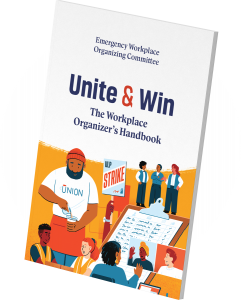Union-busting runs rampant in the U.S. In part that’s because the legal consequences for obstructing a free and fair union election amount to little more than a slap on the wrist. But a new ruling from the National Labor Relations Board (NLRB) could change that. On August 25, the NLRB announced a new framework for union elections that arose out of a ruling in a court case, Cemex Construction Materials Pacific, LLC.
The announcement didn’t get much coverage in major news outlets, but a lot of lawyers took notice, and anti-union conservatives wrote scathing responses bemoaning the new rules. As workers and supporters of the labor movement, we should take heart in that. If corporate America is wringing its hands over the Cemex decision, then we must be getting somewhere.
What is the Cemex decision?
The Cemex decision changes the rules for union elections in a few key ways. Previously, workers who wanted a union had to collect signed union cards from a majority of workers. If the boss refused to recognize the union, as most do, the onus was on workers to petition the NLRB for a union election. In the run-up to the election, companies typically engage in a variety of union-busting practices to sway the vote against a union. These activities can include things like captive audience meetings, disseminating anti-union propaganda, and firing or threatening workers for supporting a union. Sadly, only some of these activities are illegal.
In the past, if workers filed an unfair labor practice charge asserting that their employer had broken the law, the election could get thrown out and the NLRB could call for a re-election. But that second election was very hard for workers to win because bosses had ample time to threaten workers and attempt to sow discord. Workers were often intimidated or had left the company, making it very difficult to sustain the momentum required to win.
Now, that process has been turned on its head. According to the new rules, if the boss refuses to recognize a union that has majority support, it’s the boss, not the workers, who has to petition the NLRB for an election — and they have to do it within two weeks. If they don’t file for an election, the NLRB can issue a bargaining order requiring the boss to bargain with the union. No action from the boss could mean automatic recognition for the union.
The second major thing that’s changed is the consequences for union-busting. If workers file an unfair labor practice charge and the NLRB finds that the employer violated the law to prevent a free and fair election, the NLRB can issue a bargaining order instead of calling for a re-election. In other words, union-busting from the boss could mean automatic recognition for the union.
Altogether, these rules are designed to make it easier for workers to exercise their right to unionize.
How significant is the Cemex decision?
“I think it’s a very significant decision,” says Kate Andrias, a professor at Columbia Law School. “It’s particularly significant because it comes alongside a number of other decisions by this board that are vindicating the goals of the statute and protecting workers’ rights.” According to Andrias, other notable decisions include “the move to make election periods shorter and more efficient, so there’s not a very long, drawn-out process of anti-union propaganda and campaigning,” as well as “the move to court to try to get workers reinstated when they’re terminated in violation of the law,” and “the move to protect more forms of worker expression.”
She notes that the new Cemex standard isn’t as progressive as previous legislation. From 1949–1969, the Joy Silk doctrine made it even easier for unions to be certified without an election. Under that ruling, employers were required to bargain with a union unless they had a “good faith doubt” that the union had majority support, in which case they could proceed to an election. Under Cemex, employers can file for an election regardless.
How does the Cemex decision make unionizing easier?
If you’re looking to form a union at work, there are a few ways in which the Cemex decision may be able to help you. First, it means that your employer could be ordered to bargain with your union if they don’t act promptly to petition for an election. They can’t just ignore you and hope you’ll go away. Second, it means that once they’ve petitioned for an election, if they meddle in the election by committing unfair labor practices, the election could get thrown out and they could be ordered to bargain with your union anyway. (Oh, the irony!)
If you’re organizing your workplace, you should carefully document every time your employer breaks the law. Make sure to file unfair labor practice charges when they do. You will need this evidence to support your case with the NLRB.
And finally, this new ruling can be applied retroactively “to all pending cases.” That means if you had a union election and you believe your employer committed unfair labor practices that swayed the vote, you can petition the NLRB for a bargaining order, similar to the one Cemex received.
Workers are already taking advantage of this. The union representing Trader Joe’s Essex in New York City has asked the NLRB for a bargaining order, alleging that Trader Joe’s committed unfair labor practices that tainted their union election back in April. If they succeed, they could be the first union to benefit from the Cemex decision. That would be a huge victory, and it could inspire more workers to follow. This, in turn, could show employers that they can’t get away with rampant union-busting like they used to.
“The more workers defend their rights, the stronger those rights will be,” says Andrias.
Should union-busting companies be quaking in their boots?
The new rules make it harder for companies to get away with really obvious union-busting, but it’s important to keep in mind that rules alone won’t stop the worst offenders.
“Employers have been violating the law pretty routinely, and some employers in particular are really notorious violators of the law,” says Andrias. “[The Cemex decision] will play some role in deterring that kind of behavior…. Part of it will depend on how frequently the [NLRB] ends up ruling that unfair labor practices are sufficient to warrant a bargaining order.”
In other words, time will tell. Workers should feel inspired to take advantage of the Cemex decision to uphold their right to unionize. Andrias says it best: “Ultimately, almost everything in labor law comes down to workers organizing and collectively standing up to enforce their rights.”
Can you summarize the Cemex decision for me?
Sure! Key takeaways from the Cemex decision:
- If you have union support from a majority of your co-workers, the NLRB’s process is now designed to make it easier to certify your union.
- If your boss fails to act in time, you could get union recognition without an election.
- If your boss engages in union-busting, you could get union recognition without an election.
- This is how it’s supposed to work in theory. Workers have to stand up to put this new ruling to the test and flex the muscle of the law.
Got any more questions? Contact us and we’ll put you in touch with a trained organizer!



